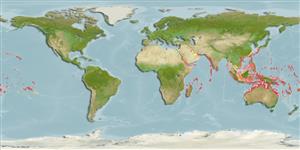Common names from other countries
>
Eupercaria/misc (Various families in series Eupercaria) >
Labridae (Wrasses) > Corinae
Etymology: Coris: Greek, kore, -es = pupil and also with themenaing of "maid" (Ref. 45335).
More on author: Lacepède.
Environment: milieu / climate zone / depth range / distribution range
Ecologia
marino associati a barriera corallina; distribuzione batimetrica 2 - 30 m (Ref. 1602), usually 2 - 30 m (Ref. 27115). Tropical; 24°C - 28°C (Ref. 27115); 30°N - 30°S
Indo-Pacific: Red Sea and East Africa (Ref. 4392) to the Line and Ducie islands, north to southern Japan, south to Lord Howe and Rapa islands.
Size / Peso / Age
Maturity: Lm ? range ? - ? cm
Max length : 120 cm TL maschio/sesso non determinato; (Ref. 5213)
Spine dorsali (totale) : 9; Raggi dorsali molli (totale) : 12 - 13; Spine anali: 3; Raggi anali molli: 12. Caudal fin slightly rounded in females, truncate and with filamentous rays in large males; pelvic fins of males very long. Large males also become uniformly dark-green and develop a gibbus forehead and an elongate first dorsal spine (Ref. 1602). Juveniles distinct with the false eyes, shaded by orange (Ref. 48636).
Occurs in the vicinity of sand or rubble patches of exposed outer reef flats, lagoon reefs, and seaward reefs (Ref. 1602), often in semi-exposed surge zones (Ref. 48636). Adults solitary. Juveniles common in shallow tide pools (Ref. 30573). Feeds mainly on hard-shelled invertebrates including crustaceans, mollusks and sea urchins (Ref. 9823). Minimum depth reported from Ref. 27115. Randall (1999, Ref. 33411) question identity of specimens exceeding 70 cm.
Life cycle and mating behavior
Maturities | Riproduzione | Spawnings | Egg(s) | Fecundities | Larve
Oviparous, with distinct pairing during breeding (Ref. 205).
Randall, J.E., 1999. Revision of the Indo-Pacific labrid fishes of the genus Coris, with descriptions of five new species. Indo-Pac. Fish. (29):74 p. (Ref. 33411)
IUCN Red List Status (Ref. 130435)
CITES (Ref. 128078)
Not Evaluated
Threat to humans
Harmless
Human uses
Pesca: scarso interesse commerciale; Pesce da pesca sportiva: si; Acquario: Commerciale
Strumenti
Special reports
Download XML
Fonti Internet
Estimates based on models
Preferred temperature (Ref.
115969): 24.6 - 29, mean 27.5 (based on 892 cells).
Phylogenetic diversity index (Ref.
82804): PD
50 = 0.5000 [Uniqueness, from 0.5 = low to 2.0 = high].
Bayesian length-weight: a=0.00813 (0.00475 - 0.01391), b=3.13 (2.98 - 3.28), in cm Total Length, based on LWR estimates for this species & (Sub)family-body (Ref.
93245).
Trophic level (Ref.
69278): 3.7 ±0.53 se; based on food items.
Resilienza (Ref.
120179): Molto basso, tempo minimo di raddoppiamento della popolazione più di 14 anni (Preliminary K or Fecundity.).
Fishing Vulnerability (Ref.
59153): High to very high vulnerability (72 of 100).
